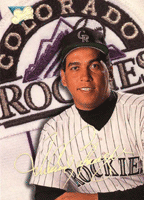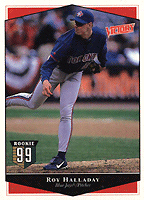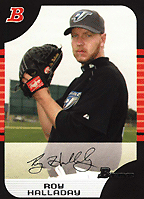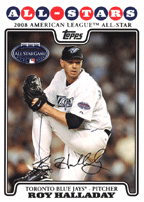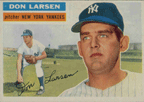| Roy Halladay — Biography | ||||||
| bio | photos | facts | my say | what they say | ||
If Cooperstown ever erected a statue to Work Ethic, it would look like Roy Halladay. Though he commanded multiple out pitches, it was his commitment to preparation and training—and his in-game patience and demeanor—that enabled him to win nearly 100 more games than he lost in a spectacular career. A winner of a Cy Young Award in each league, Roy always aimed for two things: a World Series championship and perfection. Though he fell achingly short of the former, he achieved the latter, and was also known for finishing what he started. Roy’s untimely death at the age of 40 robbed the sport of one of its most exceptional human beings, both on and off the field. This is his story…
| |
GROWING UP
Harry Leroy Halladay III was born on May 14, 1977, in Denver, Colorado. (Click here for today's sports birthdays.) His parents, Linda and Harry Jr., had two other children, Merinda and Heather. Roy, who went by his shortened middle name, was the middle child.
The Halladays lived in the town of Arvada, a Denver suburb. Roy and his dad—a professional pilot who had played the outfield in sandlot ball—began playing catch with a hardball when he was three. He was on a T-ball team at five.
A natural athlete, Roy was tall, graceful and coordinated, showing early promise in baseball and basketball. What truly separated him from the other boys in town was the intensity he exuded in game situations. When Roy was able to harness his temper, great things happened. Often, however, it got the better of him.
Roy’s parents supported his sports ambitions and became angry with those who felt it was necessary to point out that being a pro ballplayer was a million-to-one shot. They often threw batting practice to Roy in the park down the street, with his sisters shagging flies.
Roy had the mind and body of a pitcher, and as he progressed from schoolyard games to Little League and up through American Legion ball, he learned how to dominate enemy batters. When the Colorado weather kept him indoors, he lifted weights and worked out in the family’s basement, where his dad had built a batting cage and pitching mound. Roy read up on his craft whenever he could and considered Tom House’s book on pitching his Bible.
The Halladays’ only concerns about Roy’s pursuit of baseball was how hard he took losses and how much pressure he placed on himself to succeed. Often, a throwing or hitting session was followed by a family activity, such as swimming or kite-flying. These fun excurions helped Roy chill out.
In 1991, Roy entered Arvada West High School, where he would make the varsity basketball and baseball teams. A couple of years earlier, Roy had started working with an area scout named Bus Campbell. Campbell was something of a guru when it came to pitching mechanics, and he tinkered with Roy’s delivery and shortened his stride. Campbell’s most important piece of advice to Roy was convincing him to join Arvada West’s cross-country team, which helped him build his stamina and stay in shape during the fall. He took to the sport quickly, and also attracted the attention of the school’s football coach, who asked him to try out for the varsity. Campbell advised against it.
In the spring of Roy’s sophomore year at Arvada West, the Colorado Rockies played their first season. Roy and his friends got their first up-close look at major leaguers. They rooted for hitters Andres Galarraga, Dante Bichette and Eric Young, and winced when the Colorado pitchers got lit up, which was early and often.
Roy soon became a pretty famous Denver-area ballplayer in his own right. He pitched in 48 games for coach Jim Capra’s Wildcats between 1992 and 1995, going 25-2 with a 0.55 ERA. In his senior season, he allowed just 24 hits and only five earned runs in 63 innings, while striking out 105. He was named All-Conference and All-State for three years, plus League and State MVP twice.
Coach Capra’s most vivid memory of Roy, however, came off the field. He and his players were on the team bus waiting for their ace to join them on the trip to the state semifinals. When Roy showed up, he was hobbling with a cast on his leg. Capra almost lost it. Roy grinned and pulled off the cast—a fake made by the team’s trainer.
By 1995, Roy had reached his full height of 6-6. He had also developed a funky curve to go with a fastball that was consistently in the 90s. Campbell, who scouted for the Blue Jays, implored the team to draft Roy. Fellow scout Chris Bourios concurred and Toronto made him the 17th pick overall in the '95 draft.
ON THE RISE
The road to Toronto started well enough. Just weeks after signing with the Blue Jays for a $895,000 bonus, Roy was sent to Dunedin, Florida, home the franchise's Rookie League team. He became the staff ace, starting eight games during the second half of the season. Roy struck out nine batters twice and combined for a shutout in his final start of the season to earn Gulf Coast Pitcher of the Week honors.
In 1996, Roy was assigned to Toronto’s High Class A team, where he began to rub elbows with some of the Jays’ better prospects, including Ryan Freel and Kelvim Escobar, who would go on to star for other major league teams. Roy led all Blue Jays minor leaguers in wins with 15, captured the R. Howard Webster Award (as team MVP) and was the organization’s Minor League Player of the Year. He made his mark with five straight victories early in the season and went eight starts without allowing more than two runs. In July, he was honored as the organization’s Pitcher of the Month and was named to the Florida State League All Star team. Roy capped off the season by being named Toronto's top prospect by Baseball America.
Roy also started toying with a changeup in 1996. It would become one of his bread-and-butter pitches. His fastball, meanwhile, regularly touched 95 mph.
Roy spent 1997 on the next two rungs of the organizational ladder, opening the season in Double A Knoxville, and then quickly earning a promotion to Triple A Syracuse. He struggled in Knoxville, but the Blue Jay brass thought enough of him to send him to the top level of the minors. Having just turned 20, he was the youngest player in the International League.
After starting off 0-5, Roy pushed his record to 10-7. He picked it up in late June and threw his first complete game shutout, and then followed with another in early August. By the end of the season, he was ranked the fifth best prospect in the International League and was rated as having the best fastball in the minor leagues.
![]()
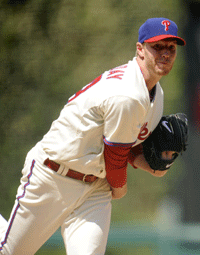
Photo © Rob Tringali/SportsChrome
Click here to see more photos
After a brief look from the Blue Jays in spring training, Roy was sent back to Syracuse for 1998. He struck out 71 in 116 innings and posted an ERA of 3.79, good for sixth in the International League. He gained the attention of the big club at year's end and made his major league debut on September 20, earning a no-decision at Tampa Bay. He pitched five innings and allowed two earned runs, while striking out the first batter he faced, Devil Rays all-star Randy Winn.
At 21, Roy was the third-youngest pitcher to ever start a game for the Blue Jays. Two weeks later, he almost made baseball history in his second start. Going against the Detroit Tigers, he took a no-hitter into the ninth inning. With two outs, he allowed a home run to Bobby Higginson but still finished the game surrendering just the one hit, striking out eight and walking none. He threw a first-pitch strike to 21 of 29 batters. Roy closed out the season with a sure trip to Toronto to open 1999.
Roy spent his first full year in the big leagues in '99, pitching in 36 games (starting 18 of them). He was a steady 8-7 with a 3.92 ERA and got his first save in his first game as a relief pitcher against the Minnesota Twins in April. A month lafter, he continued his mastery over the Tigers with a complete game shutout. Except for a rocky August, Roy was a solid member of the starting rotation.
Just when things seemed to be coming together for Roy, they began to fall apart. The 2000 season was so disheartening that he actually contemplated retirement. After 19 games and 13 starts, he had a 4-7 record with a 10.64 ERA. With opponents hitting a robust .350 off him, he was handed a ticket back to Syracuse. The problems started when the Blue Jays convinced Roy to abandon the knuckle-curve he had developed. He stuck with the plan at Triple-A and continued to get hammered. Eventually, he was demoted all the way to Single-A Dunedin, where he opened the 2001 season.
Devastated by the turn his career had taken, Roy felt he had no choice but to trust Toronto’s brass. The team was concerned that he wasn't using his natural energy and intensity to his advantage. Instead, Roy would get so keyed up during games that he tended to overthrow. He also had to make mechanical changes. Roy consulted with a sports psychologist to start the arduous journey back to the big leagues—a journey that began with the long bus rides and cheap motel rooms of Class A ball.
Roy had plenty of time to ponder his predicament. In time, he came to see that pitching wasn’t about blowing the ball past hitters. Much of the game took place between the ears, and that is where he did most of his work that spring.
Satisfied that he was headed in the right direction, the team promoted Roy to Knoxville. There it all began to come together. Roy mastered the split-finger fastball that would complement his two-seamer and four-seamer. After five starts and three complete games, he found himself back in Toronto.
Roy was delighted to discover that he could get major league hitters out again, and that he had the full confidence of Toronto’s manager, Buck Martinez. He started 16 games and went 5-3. In his first game back, Roy struck out 10 Montreal Expos in six innings. He won his first three decisions of August, and then pitched a complete game two-hit shutout against the Cleveland Indians on the final day of the season. Roy was back and the Blue Jays had big plans for what they considered the future ace of the staff.
MAKING HIS MARK
The 2002 Blue Jays finished under .500, and Carlos Tosca replaced Martinez at mid-season. The new skipper told Roy that he was his top gun, and Roy responded with a great year. He went 19-7 with a 2.93 ERA and 168 strikeouts. After a slew of no-decisions in April and May, Roy reeled off 13 wins in his next 16 decisions. He finished the year with the fifth-best ERA in the AL and the league’s sixth-best strikeout total.
There were high hopes for the 2003 Blue Jays, with the New York Yankees coming off a poor playoff showing and the Boston Red Sox pitching staff aging. Roy did his part, setting a franchise record with 22 wins. He won the Cy Young Award, and Carlos Delgado was the league’s most productive hitter. But the Jays ended the year nine games out of the Wild Card race at 86-76.
Roy made a career-high 36 starts, led the AL in innings pitched and shutouts, and tied for the league lead with nine complete games. He won 15 straight decisions from May through July, singlehandedly keeping Toronto in the playoff hunt. In July, when it appeared the Jays had to decide whether they were buyers or sellers, the club chose to do nothing, and the Yankees and Red Sox pulled away. Toronto did make one smart roster move after the season, signing Roy to a $42 million contract extension.
| |
Roy, however, was unable to reproduce his marvelous '03 campaign in 2004, as shoulder tendonitis sent him to the DL twice during the summer. The Blue Jays were relieved when no tear was found but disappointed with Roy’s 8-8 record. Compensating for his sore wing, he lost the arm angle on his cut fastball and the break on his killer curve. Without their ace, the Jays fell to a dismal 67-94 record. John Gibbons replaced Tosca at mid-season.
The Jays climbed back toward respectability in 2005, with Roy leading the way. He regained command of his repertoire and improved his change-up. By the All-Star break, he looked good for his second Cy Young, but a line drive off the bat of the Texas Rangers’ Kevin Mench broke his left tibia and just like that he was done for the year. Roy finished 12-4 with a 2.41 ERA in little over half a season. The team pulled together in the second half and finished 80-82.
The 2006 Blue Jays once again believed the Yankees and Red Sox were prime for the taking. They were right about Boston, but dead wrong about New York. As these two perennial division leaders battled during the summer, the Jays quietly slipped past the Sox into second place. But there would be no catching the Yankees, nor any of the Wild Card. Still, Toronto made a good showing with an 87-75 record.
Roy once again was among the top starting pitchers in the league, posting a 16-5 record with a 3.18 ERA in 32 starts. Again, he was among the Cy Young candidates, but a strained forearm convinced the Jays to shut him down for his final two starts. He had tweaked the same spot at the beginning of the year, so with 220 innings already under his belt and no shot at the playoffs, everyone thought the early exit was a good idea.
Roy showed no signs of his injury as he began 2007 with a perfect 4–0 record. He missed two weeks in May after undergoing an appendectomy but was back to full strength by the All-Star Break. Roy was money in the second half, throwing five complete games to finish with a league-leading total of seven. He also led all pitchers with 116 innings pitched after the break.
Roy finished with a 16–7 record andwas nearly unbeatable at home, winning 11 of 12 decisions. The Toronto bullpen, crippled by a season-ending injury to BJ Ryan, bungled a few leads. Otherwise Roy might have won 20.
Ryan’s injury was one of more than a dozen that kept key players out of the lineup for Toronto. The Jays still managed to win more often than they lost, finishing third in the AL East with 83 victories. Young starters Shaun Marcum and Dustin McGowan showed enough promise to give fans hope for 2008, but there was still the problem of edging past the Yankees and Red Sox to reach the postseason.
And, in 2008, there were also the revamped Rays to deal with. Indeed, Tampa Bay was quickly developing into a perennial contender. Toronto played better baseball throughout the season. The Jays pitched remarkably well, won more games—and finished fourth in the division! The team dug itself a hole early with a lack of hitting and never recovered. Manager John Gibbons was fired in June, and Cito Gaston returned to the helm. Toronto bounced back under its new skipper, finishing with 86 wins.
Twenty of those belonged to Roy, who had a spectacular season. It nearly ended when Nyjer Morgan smashed a line drive off his head in an interleague game. The ball was caught for the inning's third out by third baseman Scott Rolen, and to the amazement of his teammates, Roy walked back to the dugout. He was pulled from the game as a precaution. Ten days later, he shut out the Mariners. Two starts later, he blanked the Yankees on two hits. Win #20 also came against the Bronx Bombers, in Roy’s final start. It marked the fifth time he beat them in 2008.
Roy set a new career high with 206 strikeouts and led the league with nine complete games and 246 innings pitched. He finished a close second to Cliff Lee in the Cy Young voting. The Cleveland lefty was the only pitcher who had a better ERA than Roy’s 2.78.
Roy made his seventh and final Opening Day start for Toronto in 2009. It was a bittersweet season, as the Blue Jays faced the fact that they would be unable to re-sign him after 2010. Toronto fans knew the team would likely have to trade him. As the Jays sank in the standings—and Roy ran his record to 8–1 and was named the AL All-Star starter— that became the talk of baseball as the year wore on. GM J.P. Ricciardi was determined not to give him away and rebuffed several offers, including one from the pennant-bound Phillies.
To the astonishment of most fans, Roy finished the year in Toronto. He went 17–10 with nine complete games and a personal-best four shutouts. He topped the previous season’s strikeout total by two, with 208, while turning in a nearly identical 2.79 ERA.
The Phillies ultimately got their man , but not until they missed a second straight world championship. Roy landed in Philadelphia as a spoke in the wheel of a four-team transaction. Philly gave up Cliff Lee and prospects Kyle Drabek, Michael Taylor and Travis D'Arnaud.
Although pitching home games for the Phillies leaves little margin for error, Roy found the offensive support he received in April very much to his liking. Also, he didn’t mind facing lineups without a DH. It all added up to a solid start that saw him on pace for a 20-win season through May.
Roy’s first major highlight came against the Florida Marlins. On May 29, he fired the 20th perfect game in major league history. Roy fanned 11 en route to becoming the second Phillie to hurl a perfecto. The first was Hall of Famer Jim Bunning in 1964.
Roy continued to pitch lights-out baseball for the Phillies, who erased an early-season deficit and climbed into first place in the NL East. They held off the surprising Braves the rest of the year and finished with 97 wins, the most in all of baseball. Considering that all of their key hitters—Jimmy Rollins, Chase Utley, Ryan Howard and Shane Victorino—missed significant time to injury, Roy’s contributions on the mound were absolutely vital.
Roy led the league with 21 wins and 257 and 1/3 innings pitched. He was second in strikeouts with a personal-best 219 and third with a 2.44 ERA. Roy’s 1.08 walks per nine innings was the lowest mark in the NL. His four shutouts was tops in the league for the third season in a row, and he led the majors in complete games.
Roy won his 20th game of 2010 against the division-rival Braves. He shut out the Washington Nationals in his final start of the year for win number 21.
None of these accomplishments compared to the thrill of pitching in the postseason for the first time. Roy opened the Division Series against the Cincinnati Reds, champions of the NL Central. The offense gave him a 4–0 cushion after two innings—he drove in one and scored another— and he proceeded to mow down Reds inning after inning.
Roy’s fastball was particularly nasty, exploding all over the strike zone. The only batter to reach base was Jay Bruce, who walked in the fifth inning. Bruce had beaten Roy earlier in the year with a dramatic home run.
The final batter of the game, Brandon Phillips, topped a ball in front of the plate. Carlos Ruiz pounced on the dribbler and gunned him out at first for the first no-hitter thrown by a National Leaguer in postseason play—and only the second ever after Don Larsen’s perfect game in the 1956 World Series. Roy was the first pitcher to throw two no-hitters in a season since Nolan Ryan in 1973.
Roy was deadly efficient, finishing off the Reds with a mere 104 pitches. Their hitters got a grand total of four balls out of the infield. He went to a 3-ball count just three times.
The Reds bounced back two days later in Game 2, putting four runs on the board before the Phillies go untracked in the bottom of the 6th inning. They came all the way back to win 7–4. Cole Hamels shut out the Reds in Game 3, 3–0, to boost the Phillies into the NLCS.
In the NLCS, Roy started Game 1 against the San Francisco Giants and Tim Lincecum in a match-up of Cy Young winners. Cody Ross touched Roy for a pair of solo homers and the Giants scored twice more on a strong of two-out hits ti win 4–3. Roy took the mound again with the Phillies down 3 games to 1. This time he outdueled Lincecum to win 4–2. The Giants took the series, however, winning Game 6 by a score of 3–2.
The disappointment of Roy’s first October as a National Leaguer was lessened somewhat by a pair of off-season developments. First, he won the Cy Young Award, garnering all 32 first-place votes ahead of Adam Wainwright and Ubaldo Jimenez. Second, the Phillies reacquired Cliff Lee, who had been traded away prior to Roy joining the Phillies. In the interim, Lee had helped the Texas Rangers reach their first World Series, in 2010. Phillies fans would call the 2011 rotation of Halladay-Lee-Oswalt-Hamels the Phantastic Phour.
Roy held up his end of the deal. He pitched well all season, earning a starting nod in the All-Star Game, finishing with a 19–6 record and propelling his club to another NL East title with the best record in the majors. The Phillies faced the Cardinals in the Division Series with the homefield advantage and Roy slated to start Games 1 & 5. St. Louis had made up 10 games in September to win the Wild Card slot and were red-hot heading into the playoffs. Roy cooled them off in the opener, recovering from a three-run first inning to shut them out the rest of the way in an 11–6 victory.
The teams traded victories setting up a Game 5 showdown between Roy and his old Toronto teammate, Chris Carpenter. Rafael Furcal tripled and scored for the Cardinals in the first inning and to the great frustration of the Phillies and their fans, that was the end of the scoring. Only two other winner-take-all postseason games in history had ended 1–0. Unfortunately for Roy, he was on the wrong end of the third.
Roy’s 2012 season was marred by a muscle strain in his back—the Latissimus Dorsi. He missed two months and had a high ERA, but he managed to gut out 11 wins against 8 losses. Roy won his 200th career game early in 2013, but by early May his right shoulder was too sore to keep pitching. He landed on the DL for nearly four months, finishing 4–5 in what would be his final season. He announced his retirement in December.
Though he left the game at the relatively young age of 36, Roy was a surefire Hall of Famer. He went 203–105 in his career with more complete games (67) than anyone in a couple of generations. He led his league in CG’s 7 times and was an All-Star 8 times. The only accomplishment missing from his résumé was a trip to the World Series.
In the years that followed, Roy imparted his wisdom to minor leaguers as a guest instructor with the Phillies and Jays. He also devoted himself to his new hobby, flying. In 2017, he purchased an ICON-A5 two-seat amphibious aircraft. On December 7th, he was flying solo over the Gulf of Mexico near his Florida home when he perished in a crash in six feet of water.
ROY THE PITCHER
Roy had the fastball, curve and change-up to retire any big league batter, but it was his confidence and competitive nature that made him the pitcher he was. He often got great hitters out by surprising them with “their” pitch. Roy was able to win games without his best stuff, relying on a two-seamer/cutter combination to get big outs.
Where Roy used to count on adrenaline and pure physical power for big outs, he later had the patience to work a batter into hitting harmless grounders. He knew how to get inside an opponent’s head, and in many cases, he won baseball's can-and-mouse battles before a single ball has been thrown.
After changing his arm angle to three-quarters from over-the-top in 2000, Roy could summon three different fastballs, including a cutter. When his curve was working, he could start it at a right-hander’s head and nip the outside corner. His control was excellent, although he normally faced a lot of batters and racked up high pitch counts.
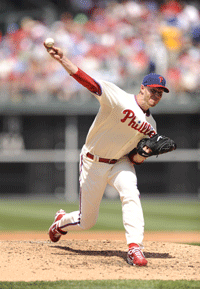
Photo © Rob Tringali/SportsChrome
Click here to see more photos
| Roy Halladay — Biography | ||||||
| bio | photos | facts | my say | what they say | ||
© Copyright 2017 Black Book Partners, LLC. All rights reserved.
